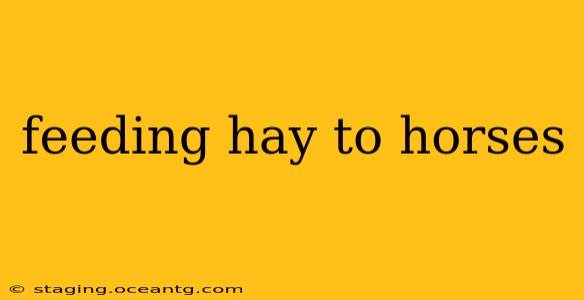Hay forms the cornerstone of a horse's diet, providing essential fiber crucial for digestive health and overall well-being. Understanding the nuances of hay feeding is vital for every horse owner, impacting everything from weight management to preventing colic. This guide dives deep into the best practices for providing your equine companion with the optimal hay diet.
What type of hay is best for horses?
The ideal hay type depends heavily on your horse's age, activity level, and any underlying health conditions. Generally, high-quality grass hays like Timothy, Orchard Grass, and Bermuda are preferred for their digestibility and lower sugar and starch content, minimizing the risk of laminitis and metabolic disorders. Legume hays, such as Alfalfa, are richer in protein and calcium but should be offered in moderation, especially to older or less active horses, due to their higher calorie and sugar content. A veterinarian or equine nutritionist can help you determine the best hay type for your specific horse. Analyzing your hay through a lab test can also provide valuable insights into its nutritional content.
How much hay should I feed my horse?
The amount of hay a horse needs varies greatly. Factors to consider include the horse's weight, age, breed, activity level, and the nutritional content of the hay itself. A general guideline is to provide 1.5% to 2% of the horse's body weight in hay daily, divided into multiple smaller meals throughout the day. For instance, a 1000-pound horse would require between 15 and 20 pounds of hay per day. Always consult with your veterinarian or an equine nutritionist to create a personalized feeding plan. Underfeeding can lead to weight loss and health issues, while overfeeding can contribute to obesity and related problems.
How often should I feed my horse hay?
Continuous access to hay is generally recommended, particularly for horses prone to gastric ulcers or colic. This helps maintain a healthy gut microbiome and prevents dangerous stomach acid buildup. If providing free-choice hay isn't feasible, aim for at least three to four smaller meals throughout the day, rather than one or two large feedings. This approach better mimics the horse's natural grazing behavior and supports a more consistent digestive process.
What are the signs of hay that is not suitable for horses?
Poor-quality hay is easily identifiable through visual and olfactory cues. Moldy hay has a musty odor and may exhibit visible mold growth – discard any hay that shows these signs as it can be toxic to horses. Dust and excessive stems indicate low nutritional value and may cause respiratory problems. Hay should be green or golden in color, with a pleasant aroma. If you are unsure about the quality of your hay, have it tested by a reputable lab. Investing in high-quality hay ensures your horse receives the necessary nutrients for optimal health.
Can I feed my horse other things along with hay?
While hay should form the foundation of your horse's diet, other supplements and feeds can be incorporated under veterinary guidance. This may include grain, mineral supplements, or specific vitamin additions to address nutritional deficiencies or meet the demands of increased activity. Never make sudden changes to your horse's diet; introduce new feed gradually to prevent digestive upsets. Always consult with your veterinarian or an equine nutritionist before making any significant dietary changes. They can help you create a balanced and tailored feeding plan to ensure your horse's health and well-being.
How do I store hay properly for horses?
Proper hay storage is paramount to maintaining its quality and minimizing waste. Store hay in a dry, well-ventilated area, away from direct sunlight and moisture. Using a covered structure or a tarp can protect the hay from rain and excessive sun exposure. Keeping hay clean and dry prevents mold growth and helps preserve its nutritional value. Regularly inspect your hay storage for signs of pests or spoilage and promptly remove any affected hay.
What are the potential dangers of feeding hay incorrectly?
Incorrect hay feeding practices can have serious consequences for your horse. Overfeeding can lead to obesity, laminitis, and metabolic disorders. Underfeeding results in weight loss, muscle loss, and weakened immune function. Feeding moldy or dusty hay can cause respiratory problems and other health complications. Improper storage can lead to spoilage and contamination, increasing the risk of various diseases. Consistent monitoring of your horse's weight, health, and fecal output, alongside regular consultation with your vet, is crucial for maintaining their well-being. Always prioritize your horse's health and safety when managing their hay intake.
This detailed guide provides a comprehensive overview of hay feeding for horses. Remember, consulting with a veterinarian or equine nutritionist is essential for creating a tailored feeding plan specific to your horse's needs. Prioritizing quality hay, proper storage, and a carefully monitored feeding schedule are vital steps in ensuring your horse thrives.
